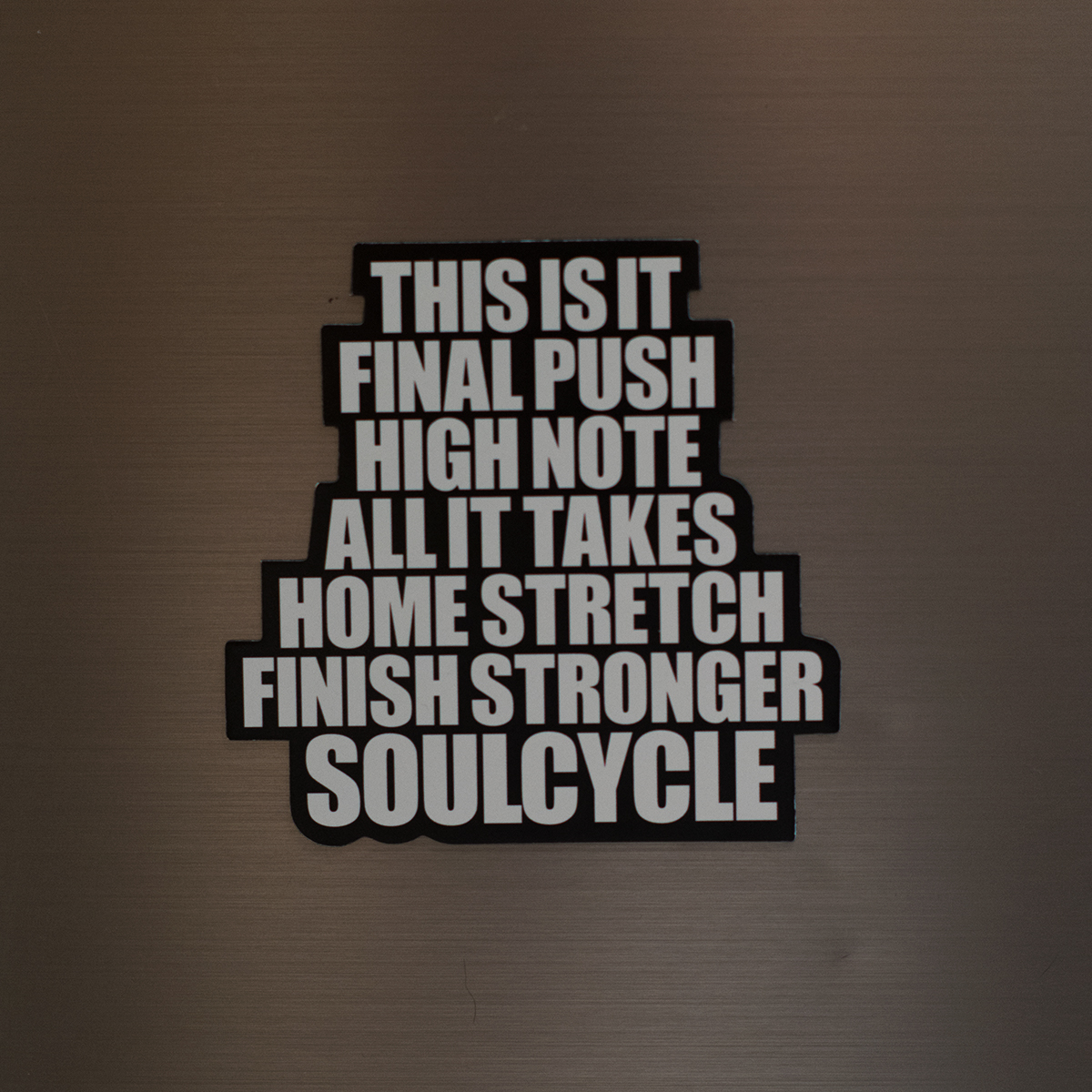Reading Time: About 6 minutes
The Skinny
- Consumers become "satiated" with brand experiences after repeated use, decreasing their perceptions of enjoyment and satisfaction over time
- Occasionally introducing variations on a product or service and signalling these upcoming variations explicitly, in advance, can improve perceptions of present brand experiences
- Net net: variety is the spice of life ... especially when we see it coming
I confess. I am a SoulCycle addict. After being cajoled on a dare to give the cult indoor cycling brand a spin in February, 2015 I quickly evolved into a zealot who “taps it back” five times a week. Interestingly, the friend who shamed me into trying SoulCycle did so by telling me I had to “do it for the brand experience.” She was right. You’ll be hard-pressed to find a brand that executes on every touch point more consistently than SoulCycle.
But this article isn’t about SoulCycle or spinning or fitness or consumer addictions. This article is about the power of variety. Specifically, the power that the promise of variety tomorrow can have on our perceived enjoyment of an experience today.
Last month, the Journal of Marketing Research published a study aptly named “Anticipation of Future Variety Reduces Satiation from Current Experiences.” First, let me begin by revisiting my favorite rant: the absurdity of the titles used in academic journal studies, which seem destined to make readers yawn and tune into Netflix. I’m convinced marketing PHDs are taught a secret handshake and given a bundle of index cards, each featuring words with no less than five syllables that are required in the title if you want to get published. But if you can get past these head-scratching riddles you will find a fascinating trove of insights—insights that otherwise wallow within the inner circle of those who possess the academic decoder ring.
This JMR study asked an interesting question about satiety. In the real world, we think of satiation as a good thing. Satiation equals contentedness, satisfaction, fulfillment. But in the marketing world satiation is a hazard light. Satiation “refers to a phenomenon in which consumers enjoy a desirable stimulus less when it is repeatedly consumed.”
I realize that this notion of satiety is counterintuitive. Conventional wisdom teaches us to focus on consistency over all. The problem is that most consumers are variety-seekers. We hunt for a new restaurant on Yelp even though our favorite eatery is just a corner away. We sample the coffee on special when we came in for our regular brew. We swipe right on Tinder while our date is in the bathroom.
Whether you’re a rabid variety-seeker or not, a mountain of research indicates that you’re sense of satisfaction with your regular brand declines ever so slightly with each repeated use. It’s not that you’re dissatisfied, it’s that the brand is failing to satisfy you as much as it did on your first few experiences. In the language of dependence, you have become tolerant of the brand experience. And as any addict will tell you, the more tolerant you become the more it takes to get you high.
The case in point for how this phenomenon affects leading brands is Apple. Consumers and critics are becoming increasingly more critical of the tech darling and it’s not because the product is failing. By many accounts, Apple continues to set the standard for other competitors. However, as the brand has matured it has become harder and harder for Apple to wow! its customers. Recent releases have been stigmatized by critical reviews that include the word “incremental,” which is code for ho-hum.
What do you do next when you are the gold standard; when you have successfully created a system that delivers at the highest standards of quality and brand experience again and again? And what do you do when all of this success leads to a customer who is increasingly underwhelmed? Again, not dissatisfied, but less satisfied.
Well, the JMR study reports a curious finding. Namely, researchers Julio Sevilla, Jiao Zhang, and Barbara E. Kahn found that the promise of something new in the future was enough to make consumers enjoy their current experience more. Think about that for a moment. Your local sandwich shop posts a notice that next week they will introduce a “grilled cheese menu.” There’s no grilled cheese on the menu today, but your turkey sandwich tastes better for some reason. In five study variations, the JMR team proved that your turkey sandwich probably tasted great in the present experience because you were excited about the grilled cheese you imagined you would eat next week.
In the language of dependence, you have become tolerant of the brand experience. And as any addict will tell you, the more tolerant you become the more it takes to get you high.
Why does next week’s grilled cheese make today’s turkey sandwich better? The JMR team doesn’t offer specific explanations, but they do rule out some common assumptions. First, they prove in one study that the effect is not because consumers perceive that they will be denied their turkey sandwich in the future. In other words, the lessening of satiation (and remember, in marketing lingo our goal is to lessen, not greaten, feelings of satiation because satiation = less satisfaction) was not driven by a feeling that the current experience would somehow go away.
The team also ruled out the power of variety alone. In other words, you can’t just lessen satiation by priming consumers with thoughts of variety. Instead, the studies indicated that it was necessary to promise specific variety in the future experience. You can’t just pepper your customers with “what if” scenarios. You have to signal that a change is coming for the effect to work.
This takes me back to my SoulCycle addiction. After two years and 400+ rides I’ve noticed that it’s harder and harder for me get as zealous as I did on those first rides. But SoulCycle frequently deals a card from the JMR variety playbook. A few times a year, it issues a Turn It Up 20 challenge: rider are challenged to complete 20 rides in a month. If they achieve their goal, they receive a badge of honor (usually some swag). The cynical among you will note that such a promotion is designed to get customers to burn through more rides, thereby driving incremental revenue. I’m sure this is indeed true from a business perspective. But from a consumer behavior perspective the program also lessens satiation. For most riders, the challenge will increase their number of rides and push their bodies to a higher degree of fitness. The challenge creates anticipation and variety: a different routine, a journey toward a fitness milestone, the possibility of riding with new instructors and on different days or times. If the JMR study is correct, the rides taken before the challenge starts are more enjoyable, too, even though those rides haven’t really changed at all.
SoulCycle does this brilliantly again and again. Last month, I participated in a challenge that dared customers to ride with five different instructors in a 10-day period. The swag was a refrigerator magnet, itself an unlikely motivator for someone paying $30 to ride on a stationary bike. The benefit was really the promise of future variety (getting out of a routine that creates satiation). The truth is any business or brand can do the same. With a little creativity brand and product teams can engage customers and elevate their sense of satisfaction by mixing things up. One easy way to execute this strategy is to think of ways that customers can introduce others to the experience. I recently wrote about the hidden power of sharing and how new research has demonstrated that consumers perceive brand experiences to be better when they are shared with someone else. Getting back to SoulCycle, it is a group class that “rides as a pack” and the sharing of accomplishments within that pack is highly encouraged.

The magnet I earned for completing the FINISH STRONG challenge. New research suggests that the variety of experiences I anticipated to compete in this challenge made my earlier rides more satisfying.
The implications of this research are revealing for brands of every type. As I wrote in Brand Real, you will never have a great brand if you can’t consistently meet or exceed your customer’s expectations in every experience. But if you only focus your attention on consistency and satisfaction you are potentially making your brand vulnerable to competitive encroachment or substitute experiences. Brands that succeed in the long term know that they have to romance their customers if they want the relationship to last. That romance requires the occasional act of seduction—of promising something tomorrow that will make the experience today all the more powerful.
Of course, you have to deliver on that promised future experience. You can’t just talk, you have to do. And the future experience has to be great or you’ll begin the downward spiral of over-promising and under-delivering. But this research casts a shadow on the somewhat secretive surprise tactics of many brands—where a new product, service or feature suddenly springs on the customer. While that act of surprise can be exciting and profitable, the brand may have missed out on the opportunity to sustain existing product lines or improve satisfaction in the time leading up to the new arrival.

